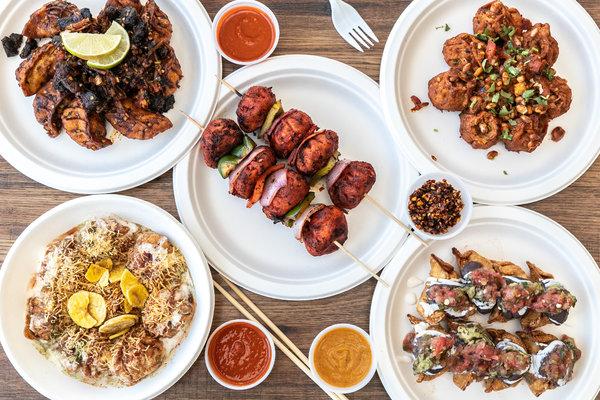A momo is a dumpling, and yet.
The definition is technically correct but almost a diminishment. Momos may be plump as pincushions, swelling at the seams; or half-moons pleated so meticulously, they look carved; or hulks, furrowed and looming, small-scale analogues to the Himalayan peaks where they were born.
Whatever the dumplings’ size, their skins are delicate enough that, when steamed, the shadow of the filling shows through: sometimes meat, sometimes a jade pulse of chives, but always seething, with juices on the run.
And then there are the deep-fried momos at Momo Crave, just off the 7 train on the border of Woodside and Jackson Heights, Queens. They are dark orange-red globes with skins gone crisp, thrust on a skewer like tandoori chicken. They also taste like tandoori chicken, earthy and fervid, with a cool touch of yogurt and swallowed smoke from the grill.

Momo Crave specializes in unorthodox dumplings, including ones thrust on skewers like tandoori chicken, layered like Indian chaat or dressed up like tacos.CreditJeenah Moon for The New York Times
“Momos are already famous,” said Mingma Sherpa, who opened the tiny shop in July with her friend Jyoti Manandhar. Natives of Nepal, they felt a need to stand out in a crowd, as this part of Queens is home to both the city’s finest momos and their makers, immigrants from the roof of the world who have settled here and now number in the thousands.
So the women decided to experiment, taking inspiration from YouTube videos featuring novelty dumplings that had become popular in Nepal and neighboring India — like the tandoori momo, whose invention is often credited to the Chinjabi (Chinese-Punjabi) chain QD’s in New Delhi. (Momos have become so popular in India that last year a politician from Jammu in the north staged a protest at which he called the dumplings a threat to national identity and had them burned in effigy under a sign that read “Silent Killer.”)
In Momo Crave’s version, the fillings — beef laced with chives, chicken bright from cilantro and broken-down soy patties that taste convincingly carnal — stay juicy inside their crunchy shells. There’s heat, too, blooming late and fierce, an open challenge to the milder tandoori marinades around town.
For other innovations, the momos — sometimes crescents, sometimes spheres — are likewise deep-fried, so that they’ll survive the tumult of colliding with other ingredients in a hot pan. Once properly armored, the dumplings might be tossed with nubs of sukuti, water buffalo meat rubbed with salt and hung over the stove for a few days until close to desiccated, so that only pure flavor is left.
In sandeko momo (sandeko meaning “marinate” in Nepali), the dumplings are doused with chile paste and clarifying mustard oil and half-buried under a rubble of roasted soybeans. Elsewhere, momos are turned into chaat, in the tradition of Indian street snacks, bathed in yogurt, sour-sweet tamarind sauce and a rousing green chutney. On top, there’s a spillover of sev, kinks of fried besan (chickpea flour), and banana chips with a sheen of coconut oil.
Mingma Sherpa, left, and Jyoti Manandhar opened the small momo shop in July.CreditJeenah Moon for The New York Times
The restaurant is spartan but cheerful, with orders placed at the counter and just a handful of tables. Ms. Sherpa and Ms. Manandhar cook alongside Phurba Lama in the kitchen, turning out respectable chow mein, nostalgically salty, and a mixed plate called samay baji, a generous pileup of Nepali specialties including bara, a rugged lentil pancake, and chyura, rice beaten flat.
Also on the menu are classic steamed momos, to be dipped at will in your choice of an earthy tomato-sesame chutney or a small fury of smashed dried chiles and salt, almost as bitter as it is hot. (Giant squeeze bottles of each are handed back and forth between tables.)
For jhol momo, steamed dumplings are immersed in a near-soup, akin in spirit to the mellower dipping sauce but more liquid and lightened by lemon. Kothey momo are steamed and fried, the best of both worlds, bottoms browned and crisped while the tops stay baggy and louche.
These are tastes from back home. But here, too, are deep-fried momos shaped like waning moons, approximating little hard taco shells. They come daubed with salsa, guacamole, sour cream and black beans cooked down to a thick paint.
It’s a nod to Ms. Sherpa’s and Ms. Manandhar’s new home — to their Mexican neighbors and the taco carts that share the streets with momo trucks within the echo of the 7 train; to the plenty of Queens.



